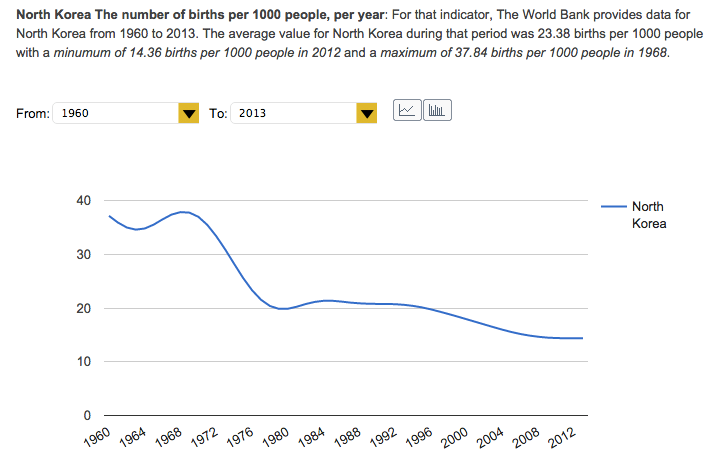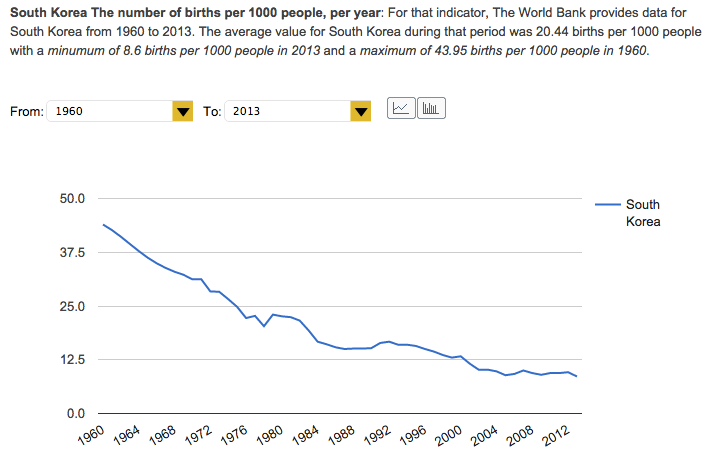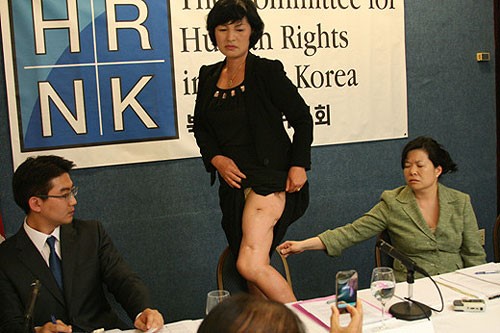|
By Amanda Mortwedt Oh, HRNK Project Officer October 2015 Radio Free Asia (RFA) recently reported that a new central policy was issued to North Korean healthcare workers on October 8, 2015, directing gynecologists not to perform abortions or implant birth control devices in their patients, and stating that birth control measures are illegal. Evidence suggests, however, that forced abortions are carried out in North Korea’s detention facilities, especially when the unborn baby is suspected to be “half-Chinese.” As HRNK has uncovered repeatedly in its research and reports, most recently in The Hidden Gulag IV: Gender Repression & Prisoner Disappearances by David Hawk, forced abortions are just one horrifying tactic the North Korean regime implements against women, something Mr. Hawk refers to in his report as a component of “gender repression.” Ms. Kim Min-ji, a former North Korean prisoner interviewed by Hawk, witnessed forced abortions during both of her forcible repatriations from China to North Korea. “The first time, in 2008, a pregnant woman was forced to take some medicine, after which the baby was aborted. The second time, in 2012, the holding center authorities had a baby surgically removed from the womb of a woman who was in the ‘last days of pregnancy.’ The baby was killed.”[1] While this post is not meant to analyze the pros and cons of a state ban on abortion, it is meant to highlight the hypocrisy and discrepancy created by this reportedly new anti-abortion and family planning policy and the inhuman practice of committing forced abortions inside North Korea’s detention facilities. According to one RFA source, “‘Punishments for those who perform illegal abortions and use contraceptive devices are already in place, but this new policy bans all kinds of abortions and birth control procedures, including even those performed at hospitals.’” Reported punishments for violating this policy include imprisonment for up to three years and heavy fines. Although the article predicts that the policy will not be effective in curbing these practices, it also highlights the apparent rationale behind the Kim regime’s policy: to hinder a “rapidly” declining birthrate.[2] Data from The World Bank, however, suggests a slowly declining birth rate as opposed to a “rapidly” declining birth rate. According to the data, in 2012, North Korea hit its lowest birth rate at 14.36 births per 1,000 people, but interestingly, the CIA’s World Factbook estimates that North Korea’s current birth rate in 2015 is actually 14.52 births/1,000, indicating a slight increase. When contrasted with South Korea’s birth rate, which has also declined since the 1960s and had a 2013 rate of 8.6 births per 1,000 people, as the graph below depicts, North Korea has a higher birth rate. On its face, the new anti-abortion and birth control policy may be about countering a low birth rate in North Korea, but the regime may have other incentives for controlling its people in this way. As HRNK’s Executive Director, Greg Scarlatoiu, suggests, perhaps the policy has been implemented to “artificially increase the population, currently half that of South Korea's.” The World Bank’s data showing North Korea’s declining birth rate over the years. Credit: theGlobalEconomy.com[3] The World Bank’s data showing South Korea’s declining birth rate over the years. Credit: theGlobalEconomy.com[4] In striking contrast to this anti-abortion policy, though, former North Korean prisoner testimony documented in HRNK’s reports, such as in the aforementioned The Hidden Gulag IV (2015) and in The Hidden Gulag Second Edition (2012), and also published on this site under the “Victims” tab, tells the gruesome memories of severe trauma faced by former political prisoners. Mrs. Bang Mi-sun, during her pretrial detention experience in North Korea, recalled that: In early 2002, at Musan An-jeon-bu, there was a group of ten pregnant women who were going to be taken to the local hospital to abort their “half-Chinese” babies. One twenty-one year old, who was seven months pregnant, refused to go to the hospital to give up the baby growing inside her. The guards put her on the floor on her back and placed a board over her swollen womb, and pistol-whipped two male prisoners until they agreed to jump up and down on the board. After five minutes or so, the baby was aborted, and the woman was taken to the hospital where she died. Mrs. Bang learned of her death when she was taken to the hospital for more treatments for her infected leg. Mrs. Bang Mi-Sun, former North Korean political prisoner, showing her scarred leg. © Committee for Human Rights in North Korea (HRNK) Testimony from the United Nations Commission of Inquiry on Human Rights in the Democratic People’s Republic of Korea (UN COI) produced more of the same shocking stories of forced abortions in North Korea’s detention facilities reminiscent of the Nazi concentration camps. One witness recollected:
…there was this pregnant woman who was about 9 months pregnant. She worked all day. The babies who were born were usually dead, but in this case the baby was born alive. The baby was crying as it was born; we were so curious, this was the first time we saw a baby being born. So we were watching this baby and we were so happy. But suddenly we heard the footsteps. The security agent came in and this agent of the Bowibu [State Security Department] said that… usually when a baby is born we would wash it in a bowl of water, but this agent told us to put the baby in the water upside down. So the mother was begging. ‘I was told that I would not be able to have the baby, but I actually got lucky and got pregnant so let me keep the baby, please forgive me’, but this agent kept beating this woman, the mother who just gave birth. And the baby, since it was just born, it was just crying. And the mother, with her shaking hands she picked up the baby and she put the baby face down in the water. The baby stopped crying and we saw this water bubble coming out of the mouth of the baby. And there was an old lady who helped with the labour, she picked up the baby from the bowl of water and left the room quietly. So those kind of things repeatedly happened. That was in the detention centre in the city of Chongjin of Hamgyong Province.[5] Unfortunately, the State’s efforts to control life and death in North Korea amount to, at the least, a disproportionate impact on women, characterized as gender discrimination and repression, and at the most, sexual violence in the prison camps at such a gravity to constitute crimes against humanity. The findings of the UN COI concluded the same in its 2014 report: “In the political prison camps of [North Korea], the inmate population has been gradually eliminated through deliberate starvation, forced labour, executions, torture, rape and the denial of reproductive rights enforced through punishment, forced abortion and infanticide….These crimes against humanity entail extermination, murder, enslavement, torture, imprisonment, rape, forced abortions and other sexual violence…” (emphasis added). The violent and inhuman state-sanctioned practice of forced abortions inside the detention facilities “regularly subject[s] women to a level of intentional and severe mental and physical suffering that satisfies the threshold of torture as defined under article 7 of the ICCPR.”[6] Furthermore, forced abortions violate the right of physical integrity and security of person, as well as sexual and reproductive rights.[7] Clearly, the North Korean regime does not consider its inmate population as entitled to the same rights as its regular citizens, even when it comes to imposing restrictions on birth control and abortion. The UN COI noted that North Korea even contravenes its own domestic law, “which prohibits the detention of women three months before or seven months after giving birth.”[8] This almost inherent discrimination is further exacerbated by the regime’s social class system, known as songbun, which views prisoners, particularly political prisoners, as having the lowest songbun (the hostile class) and the least perceived loyalty to the regime. The North Korean regime might improve its declining birth rate if, for one, it stopped the horrendous practice of forced abortions inside its prison camps and did not detain innocent minors or pregnant women. Of course, for its regular citizens, creating a better economy–including providing adequate amounts of food and lowering the costs associated with schooling–would likely increase its birth rate too. In this case, adhering to basic human rights norms would give the regime what it wants: more North Korean citizens. Instead, the regime has chosen yet another method of controlling its citizens with this new policy that hypocritically ignores the ongoing state practice of forced abortions inside North Korea’s prison camp system. The North Korean regime is effectively ‘shooting itself in the foot’ by continuing to victimize women and unborn children inside its prison walls. [1] David Hawk, The Hidden Gulag IV: Gender Repression & Prisoner Disappearances, 121 (Washington, D.C.: Committee for Human Rights in North Korea, 2015), available at https://www.hrnk.org/uploads/pdfs/Hawk_HiddenGulag4_FINAL.pdf. [2] The CIA’s World Factbook estimates that North Korea’s birth rate in for 2015 is 14.52 births/1,000 population, https://www.cia.gov/library/publications/the-world-factbook/fields/2054.html#kn. [3] North Korea Birth rate, TheGlobalEconomy.com, accessed October 22, 2015, http://www.theglobaleconomy.com/North-Korea/Birth_rate/. [4] South Korea Birth rate, TheGlobalEconomy.com, accessed October 22, 2015, http://www.theglobaleconomy.com/South-Korea/Birth_rate/. [5] Report of the detailed findings of the commission of inquiry on human rights in the Democratic People’s Republic of Korea, UN Human Rights Council, 25th sess., Agenda Item 4, UN Doc. A/HRC/25/CRP.1, 126 (7 February 2014), available at http://www.ohchr.org/EN/HRBodies/HRC/CoIDPRK/Pages/ReportoftheCommissionofInquiryDPRK.aspx. [6] Id. Article 1 of the Convention against Torture, which also informs the definition of torture under ICCPR, article 7, defines torture as any act by which severe pain or suffering, whether physical or mental, is intentionally inflicted on a person for such purposes as obtaining from him or a third person information or a confession, punishing him for an act he or a third person has committed or is suspected of having committed, or intimidating or coercing him or a third person, or for any reason based on discrimination of any kind, when such pain or suffering is inflicted by or at the instigation of or with the consent or acquiescence of a public official or other person acting in an official capacity. On the recognition of forced abortion as an act of torture see the reports of successive Special Rapporteurs on Torture and other Cruel, Inhuman and Degrading Treatment, A/HRC/22/53 (2013), para. 48; A/HRC/7/3, para. 69. See also Human Rights Committee, General Comment No. 28, CCPR/C/21/Rev.1/Add.10, para. 11. [7] Id. See Special Rapporteur on Violence against Women, its Causes and Consequences, E/CN.4/1999/68/Add.4, paras. 45, 49. See also Beijing Platform for Action, adopted at the Fourth World Conference for Women (1995), para. 115; Committee on the Elimination of Discrimination against Women, General Recommendation 19, A/47/38, para. 22; CEDAW/C/CHN/CO/6, para. 32. [8] Id. at 126, citing The People’s Safety Enforcement Law (1992), Article 50, Clause 3.
1 Comment
|
DedicationHRNK staff members and interns wish to dedicate this program to our colleagues Katty Chi and Miran Song. Categories
All
Archives
June 2024
Categories
All
|



 RSS Feed
RSS Feed
